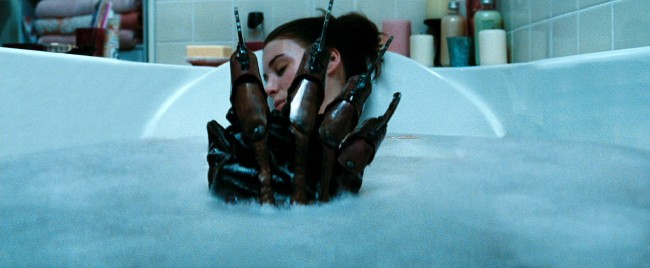A Nightmare on Elm Street
They Were More Like Finger-Knives

Starring: Rooney Mara, Jackie Earle Haley
By Tom Bevis
Freddy Krueger and his line of Nightmare films can easily be considered one of horror’s greatest and most influential contributions to the horror genre, but what a lot of people forget about him – the very same thing people forget about most of the slasher movies to come our way – is the undeniable and overwhelming camp involved with them.
It’s hard to watch any of the older Nightmare films seriously in today’s social and cultural climate, as Robert Englund cavorts around with elongated arms, leaps from behind trees and wiggles his tongue at frightened victims. It’s like watching an ill-advised live-action cartoon, and nowadays – no matter how much we may have loved the pictures in our childhoods – we just can’t help but laugh at Krueger’s jests, which range from flirtations to downright ridiculous.
Which is why a remake was absolutely necessary. The general public is no longer able to look at the previous films in the franchise as a serious entry into the genre (truly, even the original can seem like a parody of the slasher at times), and it became apparent that the film was begging to be updated. Like many others, I was skeptical about Michael Bay’s ability to handle such a project. I mean, c’mon, he’s the guy responsible for painful remakes of The Texas Chainsaw Massacre, The Hitcher, Friday the 13th, and The Amityville Horror.
All fears are alleviated, however. Not only is the film fully updated to our current cultural spectrum, but it also corrected some of the more stereotypical elements that bogged down the original film. While the cartoon antics of the film’s antagonist are gone (not to say Jackie Earle Haley was a shining star in the role – we’ll get to him later), gone too are the sexual morality play and final girl setup common in slasher films.
The story, for the most part, sticks to its original plot lines, following a group of friends plagued by fatal nightmares. The circumstances behind Freddy Krueger’s murder are tweaked to give him a more solid motive for his teenaged bloodbath, and elements of the story are moved around and switched. While the film does tend to drag towards the beginning, it quickly shapes up and paces itself well for the duration of the picture.
Sticking true, too, to the slasher, the film is populated entirely by teenage stereotypes. There’s the socially inept artist, the tortured outcast, the leather-coat wearing tough guy, and the misunderstood pretty girl. Because the roles are skewed from the first one, though, and because all of these characters can find sympathy in one form or another, it’s not easy to tell which character is going to be the next one to face Krueger’s wrath. That’s part of the film’s charm.
The settings in the film, painted in the reds and oranges of flame, are more mature and ominous than those featured in the original and offer greater senses of suspense and fear. The long, pipe-lined hallways of the original are abandoned in favor of more industrial catwalks encased by cages of pipes and fiery hues, complete with sparks and shadows. At times, the graphics leak into the grim and fantastic, like something out of American McGee’s Alice, but the entire set serves the purpose of the film beautifully.
While the acting and the script weren’t necessarily bad, the film suffers from botched delivery from a generally unspectacular cast. The weakest link is easily Kyle Gallner (A Haunting in Connecticut, anybody?), who lulls the audience to a restless sleep with his single facial expression (a monotone, droopy-eyed scowl, present whether he’s trying to woo the girl of his dreams or escape certain death), but Jackie Earle Haley isn’t helping much either.
Sure, the original Freddy Krueger was silly and witless, but at least he didn’t look like a block of cheese left to microwave for five minutes, and his voice comes off more apologetic and shameful than frightening, which may be Robert Englund’s strongest aspects. I’m not surprised to see Haley in another masked role following his – erhm – success – erhm – as Rorschach in 2009’s Watchmen, and I won’t be surprised to see him in many more raspy-voiced masked roles.
All-in-all, if you can handle strangers tweaking with what may be one of your fondest childhood memories (or perhaps the complete opposite), then Nightmare on Elm Street may be with the ten dollar movie ticket. Don’t expect Citizen Kane as you walk in – take it for what it is and you’ll be fine.
4/5
